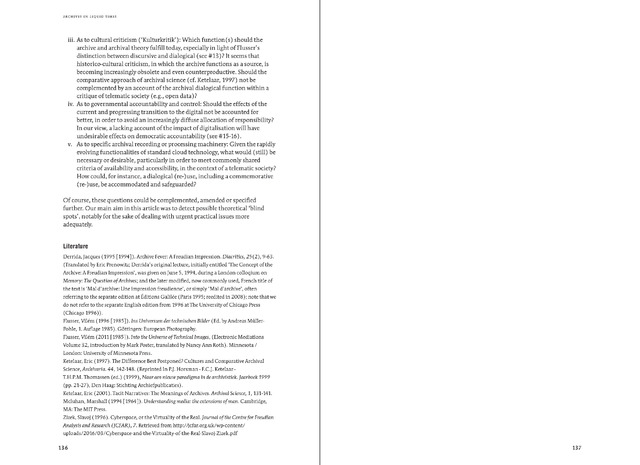iii. As to cultural criticism ('Kulturkritik'): Which function(s) should the
archive and archival theory fulfill today, especially in light of Flusser's
distinction between discursive and dialogical (see #13)? It seems that
historico-cultural criticism, in which the archive functions as a source, is
becoming increasingly obsolete and even counterproductive. Should the
comparative approach of archival science (cf. Ketelaar, 1997) not be
complemented by an account of the archival dialogical function within a
critique of telematic society (e.g., open data)?
iv. As to governmental accountability and control: Should the effects of the
current and progressing transition to the digital not be accounted for
better, in order to avoid an increasingly diffuse allocation of responsibility?
In our view, a lacking account of the impact of digitalisation will have
undesirable effects on democratic accountability (see #15-16).
v. As to specific archival recording or processing machinery: Given the rapidly
evolving functionalities of standard cloud technology, what would (still) be
necessary or desirable, particularly in order to meet commonly shared
criteria of availability and accessibility, in the context of a telematic society?
How could, for instance, a dialogical (re-)use, including a commemorative
(re-)use, be accommodated and safeguarded?
Of course, these questions could be complemented, amended or specified
further. Our main aim in this article was to detect possible theoretical 'blind
spots', notably for the sake of dealing with urgent practical issues more
adequately.
archives in liquid times
Literature
Derrida, Jacques (1995 [1994]). Archive Fever: A Freudian Impression. Diacritics, 25(2), 9-63.
(Translated by Eric Prenowitz; Derrida's original lecture, initially entitled 'The Concept of the
Archive: A Freudian Impression', was given on June 5, 1994, during a London colloqium on
Memory: The Question of Archives; and the later modified, now commonly used, French title of
the text is 'Mal d'archive: Une impression freudienne', or simply 'Mal d'archive', often
referring to the separate edition at Editions Galilée (Paris 1995; reedited in 2008); note that we
do not refer to the separate English edition from 1996 at The University of Chicago Press
(Chicago 1996)).
Flusser, Vilém (1996 [1985]). Ins Universum der technischen Bilder (Ed. by Andreas Müller-
Pohle, 1. Auflage 1985). Göttingen: European Photography.
Flusser, Vilém (2011 [1985]). Into the Universe of Technical Images, (Electronic Mediations
Volume 32, introduction by Mark Poster, translated by Nancy Ann Roth). Minnesota
London: University of Minnesota Press.
Ketelaar, Eric (1997). The Difference Best Postponed? Cultures and Comparative Archival
Science, Archivaria. 44, 142-148. (Reprinted In P.J. Horsman - F.C.J. Ketelaar -
T.H.P.M. Thomassen (ed.) (1999), Naar een nieuw paradigma in de archivistiek. Jaarboek 1999
(pp. 21-27), Den Haag: Stichting Archiefpublicaties).
Ketelaar, Eric (2001). Tacit Narratives: The Meanings of Archives. Archival Science, 1, 131-141.
Mcluhan, Marshall (1994 [1964]). Understanding media: the extensions of man. Cambridge,
MA: The MIT Press.
Zizek, Slavoj (1996). Cyberspace, or the Virtuality of the Real. Journal of the Centre for Freudian
Analysis and Research (JCFAR), 7. Retrieved from http://jcfar.org.uk/wp-content/
uploads/2016/03/Cyberspace-and-the-Virtuality-of-the-Real-Slavoj-Zizek.pdf
136
137

